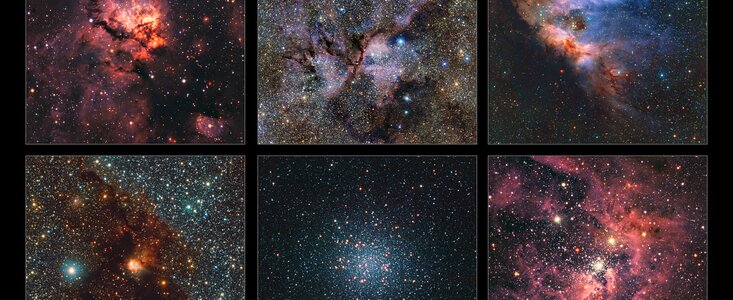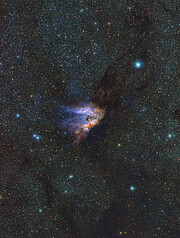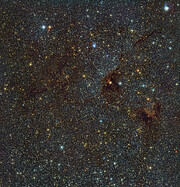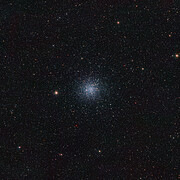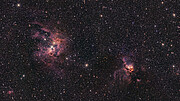Pressmeddelande
ESO-teleskop skapar den hittills mest detaljerade infraröda kartan över Vintergatan
26 september 2024, Skurup
Astronomer har publicerat en gigantisk infraröd karta över Vintergatan som innehåller mer än 1,5 miljarder objekt – den mest detaljerade som någonsin gjorts. Med hjälp av Europeiska sydobservatoriets VISTA-teleskop kartlade forskarna de centrala delarna av vår galax under mer än 13 år. Med sina 500 terabyte data är detta det största observationsprojekt som någonsin har genomförts med ett ESO-teleskop.
"Vi gjorde så många upptäckter att vi har förändrat synen på vår galax för alltid", menar Dante Minniti, astrofysiker vid Universidad Andrés Bello i Chile som ledde det övergripande projektet.
Den rekordartade kartan omfattar 200 000 bilder tagna med ESO:s VISTA-teleskop (Visible and Infrared Survey Telescope for Astronomy). Det är beläget vid ESO:s Paranalobservatorium i Chile med det huvudsakliga syftet att kartlägga stora områden på himlen. Forskargruppen använde VISTA:s infraröda kamera, VIRCAM, för att se genom stoft och gas som finns i vår galax. Därmed fångar VISTA strålningen från Vintergatans mest dolda platser och öppnar ett unikt fönster mot vår galaktiska omgivning.
Den gigantiska datamängden [1] omfattar en yta av himlen motsvarade 8 600 fullmånar och innehåller tio gånger fler objekt än en tidigare karta som släpptes av samma forskargrupp redan 2012. Kartan inkluderar nyfödda stjärnor, ofta inbäddade i sina stoftkokonger, och klotformiga hopar – täta grupper vardera med uppemot en miljon av Vintergatans äldsta stjärnor. Att observera i infrarött ljus betyder att VISTA också kan upptäcka mycket kalla objekt som lyser starkast vid dessa våglängder, som bruna dvärgar (”misslyckade” stjärnor utan ihållande kärnfusion) och friflytande planeter som inte kretsar kring någon stjärna.
Observationerna, som påbörjades 2010 och avslutades under första halvåret 2023, spänner över totalt 420 nätter. Genom att ta bilder av varje punkt på himlen flera gånger kunde astronomerna bestämma hur alla de observerade objekten rör sig och om deras ljusstyrka förändras. De kartlade stjärnor vars ljusstyrka ändras periodiskt och som kan användas som kosmiska måttstockar för att bestämma avstånd [2]. Detta har gett oss en exakt 3D-vy av Vintergatans inre regioner, som tidigare var dolda av stoft. Forskarna spårade också hypersnabba stjärnor som slungades ut ur Vintergatans centralregion efter en närpassage av det supermassiva svarta hål som finns där.
Den nya kartan innehåller data som samlats in som en del av kartläggningsprojektet VISTA Variables in the Vía Láctea (VVV) [3] och dess kompletterande projekt, VVV eXtended (VVVX). "Projektet var en monumental ansträngning som var möjligt att genomföra tack vare ett fantastiskt forskarlag", säger Roberto Saito, astrofysiker vid Universidade Federal de Santa Catarina i Brasilien och huvudförfattare till den artikel som publicerades i dag i Astronomy & Astrophysics i samband med projektets avslutning.
VVV- och VVVX-kartläggningarna har redan lett till mer än 300 vetenskapliga artiklar. När kartläggningen nu är klar kommer den vetenskapliga utforskningen av den insamlade datan att fortsätta i decennier framöver. Samtidigt förbereds ESO:s Paranalobservatorium för framtiden: VISTA kommer att uppdateras med ett nytt instrument, 4MOST, och ESO:s Very Large Telescope (VLT) kommer att ta emot sitt MOONS-instrument. Tillsammans kommer de att producera spektra av miljontals av de objekt som har undersökts i denna kartläggning, och otaliga upptäckter är att vänta.
Noter
[1] Datamängden är för stor för att publiceras som en enda bild, men katalogen med bearbetade data och objekt kan nås i ESO Science Portal.
[2] Ett sätt att mäta avståndet till en stjärna är att jämföra dess ljusstyrka sett från jorden med dess verkliga, absoluta, ljusstyrka; men den senare är ofta okänd. Vissa typer av stjärnor förändrar sin ljusstyrka regelbundet, och det finns hos dessa ett mycket starkt samband mellan perioden och den absoluta ljusstyrkan. Genom att mäta perioden på ljusstyrkevariationen för dessa stjärnor kan astronomerna därför räkna ut hur ljusstarka de är i verkligheten, och därmed hur långt bort de befinner sig.
[3] Vía Láctea är det latinska namnet för Vintergatan.
Mer information
Forskningsresultaten presenteras i artikeln “The VISTA Variables in the Vía Láctea eXtended (VVVX) ESO public survey: Completion of the observations and legacy” i Astronomy & Astrophysics (https://doi.org/10.1051/0004-6361/202450584). Data DOI: VVV, VVVX.
Forskarlaget utgörs av R. K. Saito (Departamento de Física, Universidade Federal de Santa Catarina, Florianópolis, Brazil [UFSC]), M. Hempel (Instituto de Astrofísica, Dep. de Ciencias Físicas, Facultad de Ciencias Exactas, Universidad Andres Bello, Providencia, Chile [ASTROUNAB] and Max Planck Institute for Astronomy, Heidelberg, Germany), J. Alonso-García (Centro de Astronomía, Universidad de Antofagasta, Antofagasta, Chile [CITEVA] and Millennium Institute of Astrophysics, Providencia, Chile [MAS]), P. W. Lucas (Centre for Astrophysics Research, University of Hertfordshire, Hatfield, United Kingdom [CAR]), D. Minniti (ASTROUNAB; Vatican Observatory, Vatican City, Vatican City State [VO] and UFSC), S. Alonso (Departamento de Geofísica y Astronomía, CONICET, Facultad de Ciencias Exactas, Físicas y Naturales, Universidad Nacional de San Juan, Rivadavia, Argentina [UNSJ-CONICET]), L. Baravalle (Instituto de Astronomía Teórica y Experimental, Córdoba, Argentina [IATE-CONICET]; Observatorio Astronómico de Córdoba, Universidad Nacional de Córdoba, Argentina [OAC]), J. Borissova (Instituto de Física y Astronomía, Universidad de Valparaíso, Valparaíso, Chile [IFA-UV] and MAS), C. Caceres (ASTROUNAB), A. N. Chené (Gemini Observatory, Northern Operations Center, Hilo, USA), N. J. G. Cross (Wide-Field Astronomy Unit, Institute for Astronomy, University of Edinburgh, Royal Observatory, Edinburgh, United Kingdom), F. Duplancic (UNSJ-CONICET), E. R. Garro (European Southern Observatory, Vitacura, Chile [ESO Chile]), M. Gómez (ASTROUNAB), V. D. Ivanov (European Southern Observatory, Garching bei München [ESO Germany]), R. Kurtev (IFA-UV and MAS), A. Luna (INAF – Osservatorio Astronomico di Capodimonte, Napoli, Italy [INAF- OACN]), D. Majaess (Mount Saint Vincent University, Halifax, Canada), M. G. Navarro (INAF – Osservatorio Astronomico di Roma, Italy [INAF-OAR]), J. B. Pullen (ASTROUNAB), M. Rejkuba (ESO Germany), J. L. Sanders (Department of Physics and Astronomy, University College London, London, United Kingdom), L. C. Smith (Institute of Astronomy, University of Cambridge, Cambridge, United Kingdom), P. H. C. Albino (UFSC), M. V. Alonso (IATE-CONICET and OAC), E. B. Amôres (Departamento de Física, Universidade Estadual de Feira de Santana, Feira de Santana, Brazil), E. B. R. Angeloni (Gemini Observatory/NSF’s NOIRLab, La Serena, Chile [NOIRLab]), J. I. Arias (Departamento de Astronomía, Universidad de La Serena, La Serena, Chile [ULS]), M. Arnaboldi (ESO Germany), B. Barbuy (Universidade de São Paulo, São Paulo, Brazil), A. Bayo (ESO Germany), J. C. Beamin (ASTROUNAB and Fundación Chilena de Astronomía, Santiago, Chile), L. R. Bedin (Istituto Nazionale di Astrofisica, Osservatorio Astronomico di Padova, Padova, Italy [INAF-OAPd]), A. Bellini (Space Telescope Science Institute, Baltimore, USA [STScI]), R. A. Benjamin (Department of Physics, University of Wisconsin-Whitewater, Whitewater, USA), E. Bica (Departamento de Astronomia, Instituto de Física, Porto Alegre, Brazil [IF – UFRGS]), C. J. Bonatto (IF – UFRGS), E. Botan (Instituto de Ciências Naturais, Humanas e Sociais, Universidade Federal de Mato Grosso, Sinop, Brazil), V. F. Braga (INAF-OAR), D. A. Brown (Vatican Observatory, Tucson, USA), J. B. Cabral (IATE-CONICET and Gerencia De Vinculación Tecnológica, Comisión Nacional de Actividades Espaciales, Córdoba, Argentina), D. Camargo (Colégio Militar de Porto Alegre, Ministério da Defesa, Exército Brasileiro, Brazil), A. Caratti o Garatti (INAF-OACN), J. A. Carballo-Bello (Instituto de Alta Investigación, Universidad de Tarapacá, Arica, Chile [IAI-UTA]), M.Catelan (Instituto de Astrofísica, Pontificia Universidad Católica de Chile, Santiago, Chile [Instituto de Astrofísica UC]; MAS and Centro de Astro-Ingeniería, Pontificia Universidad Católica de Chile, Santiago, Chile [AIUC]), C. Chavero (OAC and Consejo Nacional de Investigaciones Científica y Técnicas, Ciudad Autónoma de buenos Aires, Argentina [CONICET]), M. A. Chijani (ASTROUNAB), J. J. Clariá (OAC and CONICET), G. V. Coldwell (UNSJ-CONICET), C. Contreras Peña (Department of Physics and Astronomy, Seoul National University, Seoul, Republic of Korea and Research Institute of Basic Sciences, Seoul National University, Seoul, Republic of Korea), C. R. Contreras Ramos (Instituto de Astrofísica UC and MAS), J. M. Corral-Santana (ESO Chile), C. C. Cortés (Departamento de Tecnologías Industriales, Faculty of Engineering, Universidad de Talca, Curicó, Chile), M. Cortés-Contreras (Departamento de Física de la Tierra y Astrofísica & Instituto de Física de Partículas y del Cosmos de la UCM, Facultad de Ciencias Físicas, Universidad Complutense de Madrid, Madrid, Spain), P. Cruz (Centro de Astrobiología, CSIC-INTA, Madrid, Spain [CAB]), I. V. Daza-Perilla (CONICET; IATE-CONICET and Facultad de Matemática, Astronomía, Física y Computación, Universidad Nacional de Córdoba, Córdoba, Argentina), V. P. Debattista (University of Central Lancashire, Preston, United Kingdom), B. Dias (ASTROUNAB), L. Donoso (Instituto de Ciencias Astronómicas, de la Tierra y del Espacio, San Juan, Argentina), R. D’Souza (VO), J. P. Emerson (Astronomy Unit, School of Physical and Chemical Sciences, Queen Mary University of London, London, United Kingdom), S. Federle (ESO Chile and ASTROUNAB), V. Fermiano (UFSC), J. Fernandez (UNSJ-CONICET), J. G. Fernández-Trincado (Instituto de Astronomía, Universidad Católica del Norte, Antofagasta, Chile [IA-UCN]), T. Ferreira (Department of Astronomy, Yale University, New Haven, USA), C. E. Ferreira Lopes (Instituto de Astronomía y Ciencias Planetarias, Universidad de Atacama, Copiapó, Chile [INCT] and MAS), V. Firpo (NOIRLab), C. Flores-Quintana (ASTROUNAB and MAS), L. Fraga (Laboratorio Nacional de Astrofísica, Itajubá, Brazil), D.Froebrich (Centre for Astrophysics and Planetary Science, School of Physics and Astronomy, University of Kent, Canterbury, United Kingdom), D. Galdeano (UNSJ-CONICET), I. Gavignaud (ASTROUNAB), D. Geisler (Departamento de Astronomía, Universidad de Concepción, Chile [UdeC]; Instituto Multidisciplinario de Investigación y Postgrado, Universidad de La Serena, Chile [IMIP-ULS] and ULS), O. E.Gerhard (Max Planck Institute for Extraterrestrial Physics, Germany [MPE]), W. Gieren (UdeC), O. A. Gonzalez (UK Astronomy Technology Centre, Royal Observatory Edinburgh, Edinburgh, United Kingdom), L. V. Gramajo (OAC and CONICET), F. Gran (Université Côte d’Azur, Observatoire de la Côte d’Azur, CNRS, Laboratoire Lagrange, Nice, France [Lagrange]), P. M. Granitto (Centro Internacional Franco Argentino de Ciencias de la Información y de Sistemas, Rosario, Argentina), M. Griggio (INAF-OAPd; Dipartimento di Fisica, Università di Ferrara, Ferrara, Italy and STScI), Z. Guo (IFA-UV and MAS), S. Gurovich (IATE-CONICET and Western Sydney University, Kingswood, Australia), M. Hilker (ESO Germany), H. R. A. Jones (CAR), R. Kammers (UFSC), M. A. Kuhn (CAR), M. S. N. Kumar (Centro de Astrofísica da Universidade do Porto, Porto, Portugal), R. Kundu (Miranda House, University of Delhi, India and Inter University centre for Astronomy and Astrophysics, Pune, India), M. Lares (IATE-CONICET), M. Libralato (INAF-OAPd), E. Lima (Universidade Federal do Pampa, Uruguaiana, Brazil), T. J. Maccarone (Department of Physics & Astronomy, Texas Tech University, Lubbock, USA), P. Marchant Cortés (ULS), E. L. Martin (Instituto de Astrofisica de Canarias and Departamento de Astrofísica, Universidad de La Laguna, San Cristóbal de la Laguna, Spain), N. Masetti (Istituto Nazionale di Astrofisica, Osservatorio di Astrofisica e Scienza dello Spazio di Bologna, Bologna, Italy and ASTROUNAB), N. Matsunaga (Department of Astronomy, Graduate School of Science, The University of Tokyo, Japan), F. Mauro (IA-UCN), I. McDonald (Jodrell Bank Centre for Astrophysics, The University of Manchester, UK [JBCA]), A. Mejías (Departamento de Astronomía, Universidad de Chile, Las Condes, Chile), V. Mesa (IMIP-ULS; Association of Universities for Research in Astronomy, Chile, Grupo de Astrofísica Extragaláctica-IANIGLA; CONICET, and Universidad Nacional de Cuyo, Mendoza, Argentina), F. P. Milla-Castro (ULS), J. H. Minniti (Department of Physics and Astronomy, Johns Hopkins University, Baltimore, USA), C. Moni Bidin (IA-UCN), K. Montenegro (Clínica Universidad de los Andes, Santiago, Chile), C. Morris (CAR), V. Motta (OAC), F. Navarete (SOAR Telescope/NSF’s NOIRLab, La Serena, Chile), C. Navarro Molina (Centro de Docencia Superior en Ciencias Básicas, Universidad Austral de Chile, Puerto Montt, Chile), F. Nikzat (Instituto de Astrofísica UC and MAS), J. L. NiloCastellón (IMIP-ULS and ULS), C. Obasi (IA-UCN and Centre for Basic Space Science, University of Nigeria, Nsukka, Nigeria), M. Ortigoza-Urdaneta (Departamento de Matemática, Universidad de Atacama, Copiapó, Chile), T. Palma (OAC), C. Parisi (OAC and IATE-CONICET), K. Pena Ramírez (NSF NOIRLab/Vera C. Rubin Observatory, La Serena, Chile), L. Pereyra (IATE-CONICET), N. Perez (UNSJ-CONICET), I. Petralia (ASTROUNAB), A. Pichel (Instituto de Astronomía y Física del Espacio, Ciudad Autónoma de Buenos Aires, Argentina [IAFE-CONICET]), G. Pignata (IAI-UTA), S. Ramírez Alegría (CITEVA), A. F. Rojas (Instituto de Astrofísica UC, Instituto de Estudios Astrofísicos, Facultad de Ingeniería y Ciencias, Universidad Diego Portales, Santiago, Chile and CITEVA), D. Rojas (ASTROUNAB), A. Roman-Lopes (ULS), A. C. Rovero (IAFE-CONICET), S. Saroon (ASTROUNAB), E. O. Schmidt (OAC and IATE-CONICET), A. C. Schröder (MPE), M. Schultheis (Lagrange), M. A. Sgró (OAC), E. Solano (CAB), M. Soto (INCT), B. Stecklum (Thüringer Landessternwarte, Tautenburg, Germany), D. Steeghs (Department of Physics, University of Warwick, UK), M. Tamura (Department of Astronomy, Graduate School of Science, University of Tokyo; Astrobiology Center, Tokyo, Japan, and National Astronomical Observatory of Japan, Tokyo, Japan), P. Tissera (Instituto de Astrofísica UC and AIUC), A. A. R. Valcarce (Departamento de Física, Universidad de Tarapacá, Chile), C. A. Valotto (IATE-CONICET and OAC), S. Vasquez (Museo Interactivo de la Astronomía, La Granja, Chile), C. Villalon (IATE-CONICET and OAC), S. Villanova (UdeC), F. Vivanco Cádiz (ASTROUNAB), R. Zelada Bacigalupo (North Optics, La Serena, Chile), A. Zijlstra (JBCA and School of Mathematical and Physical Sciences, Macquarie University, Sydney, Australia), and M. Zoccali (Instituto de Astrofísica UC and MAS).
Europeiska sydobservatoriet (ESO) möjliggör för astronomer världen över att utforska universums mysterier. Vi designar, konstruerar och driver markbaserade observatorier av yppersta världsklass – som astronomer använder för att besvara spännande och utmanande frågor och för att sprida astronomisk kunskap – och driver internationella samarbeten inom astronomin. ESO startade som en mellanstatlig organisation 1962 och har i dag 16 medlemsländer (Belgien, Danmark, Finland, Frankrike, Irland, Italien, Nederländerna, Polen, Portugal, Schweiz, Spanien, Storbritannien, Sverige, Tjeckien, Tyskland och Österrike), tillsammans med Chile som värdland och Australien som en strategisk partner. ESO:s högkvarter och besökscenter med planetarium, ESO Supernova, ligger nära München i Tyskland, medan teleskopen är placerade i Atacamaöknen i Chile, en unik plats för astronomiska observationer. ESO driver tre observatorier i Chile: La Silla, Paranal och Chajnantor. Vid Paranal finns Very Large Telescope och Very Large Telescope Interferometer, liksom kartläggningsteleskop som VISTA. Vid Paranal kommer även ESO att placera och driva Cherenkov Telescope Array South, världens största och känsligaste gammastrålningsteleskop. Tillsammans med internationella partners driver ESO de två anläggningarna APEX och ALMA på Chajnantorplatån som observerar himlen i millimeter- och submillimetervåglängder. Vid Cerro Armazones, nära Paranal, bygger vi för närvarande ESO:s Extremely Large Telescope, ”världens största öga mot himlen”. Från kontoret i Santiago, Chile, stödjer vi verksamheten i landet och samverkar med det chilenska samhället och våra samarbetspartners.
Länkar
- Forskningsartikel
- Foton på kartläggningsteleskopen på Paranal, inklusive VISTA
- För journalister: Prenumerera på pressmeddelanden under embargo på svenska
- För astronomer: Berätta om din forskning!
Kontakter
Roberto K. Saito
Universidade Federal de Santa Catarina
Florianópolis, Brazil
E-post: roberto.saito@ufsc.br
Dante Minniti
Universidad Andrés Bello
Santiago, Chile
E-post: vvvdante@gmail.com
Phil Lucas
University of Hertfordshire
Hartfield, United Kingdom
E-post: p.w.lucas@herts.ac.uk
Juan Carlos Muñoz-Mateos
ESO Media Officer
Garching bei München, Germany
Tel: +49 89 3200 6176
E-post: press@eso.org
Johan Warell (Presskontakt för Sverige)
ESO:s nätverk för vetenskaplig kommunikation
Skurup, Sverige
Tel: +46-706-494731
E-post: eson-sweden@eso.org
Om pressmeddelandet
| Pressmeddelande nr: | eso2413sv |
| Namn: | Milky Way |
| Typ: | Milky Way |
| Facility: | Visible and Infrared Survey Telescope for Astronomy |
| Instruments: | VIRCAM |
| Science data: | 2024A&A...689A.148S |
Our use of Cookies
We use cookies that are essential for accessing our websites and using our services. We also use cookies to analyse, measure and improve our websites’ performance, to enable content sharing via social media and to display media content hosted on third-party platforms.
ESO Cookies Policy
The European Organisation for Astronomical Research in the Southern Hemisphere (ESO) is the pre-eminent intergovernmental science and technology organisation in astronomy. It carries out an ambitious programme focused on the design, construction and operation of powerful ground-based observing facilities for astronomy.
This Cookies Policy is intended to provide clarity by outlining the cookies used on the ESO public websites, their functions, the options you have for controlling them, and the ways you can contact us for additional details.
What are cookies?
Cookies are small pieces of data stored on your device by websites you visit. They serve various purposes, such as remembering login credentials and preferences and enhance your browsing experience.
Categories of cookies we use
Essential cookies (always active): These cookies are strictly necessary for the proper functioning of our website. Without these cookies, the website cannot operate correctly, and certain services, such as logging in or accessing secure areas, may not be available; because they are essential for the website’s operation, they cannot be disabled.
Functional Cookies: These cookies enhance your browsing experience by enabling additional features and personalization, such as remembering your preferences and settings. While not strictly necessary for the website to function, they improve usability and convenience; these cookies are only placed if you provide your consent.
Analytics cookies: These cookies collect information about how visitors interact with our website, such as which pages are visited most often and how users navigate the site. This data helps us improve website performance, optimize content, and enhance the user experience; these cookies are only placed if you provide your consent. We use the following analytics cookies.
Matomo Cookies:
This website uses Matomo (formerly Piwik), an open source software which enables the statistical analysis of website visits. Matomo uses cookies (text files) which are saved on your computer and which allow us to analyze how you use our website. The website user information generated by the cookies will only be saved on the servers of our IT Department. We use this information to analyze www.eso.org visits and to prepare reports on website activities. These data will not be disclosed to third parties.
On behalf of ESO, Matomo will use this information for the purpose of evaluating your use of the website, compiling reports on website activity and providing other services relating to website activity and internet usage.
Matomo cookies settings:
Additional Third-party cookies on ESO websites: some of our pages display content from external providers, e.g. YouTube.
Such third-party services are outside of ESO control and may, at any time, change their terms of service, use of cookies, etc.
YouTube: Some videos on the ESO website are embedded from ESO’s official YouTube channel. We have enabled YouTube’s privacy-enhanced mode, meaning that no cookies are set unless the user actively clicks on the video to play it. Additionally, in this mode, YouTube does not store any personally identifiable cookie data for embedded video playbacks. For more details, please refer to YouTube’s embedding videos information page.
Cookies can also be classified based on the following elements.
Regarding the domain, there are:
- First-party cookies, set by the website you are currently visiting. They are stored by the same domain that you are browsing and are used to enhance your experience on that site;
- Third-party cookies, set by a domain other than the one you are currently visiting.
As for their duration, cookies can be:
- Browser-session cookies, which are deleted when the user closes the browser;
- Stored cookies, which stay on the user's device for a predetermined period of time.
How to manage cookies
Cookie settings: You can modify your cookie choices for the ESO webpages at any time by clicking on the link Cookie settings at the bottom of any page.
In your browser: If you wish to delete cookies or instruct your browser to delete or block cookies by default, please visit the help pages of your browser:
Please be aware that if you delete or decline cookies, certain functionalities of our website may be not be available and your browsing experience may be affected.
You can set most browsers to prevent any cookies being placed on your device, but you may then have to manually adjust some preferences every time you visit a site/page. And some services and functionalities may not work properly at all (e.g. profile logging-in, shop check out).
Updates to the ESO Cookies Policy
The ESO Cookies Policy may be subject to future updates, which will be made available on this page.
Additional information
For any queries related to cookies, please contact: pdprATesoDOTorg.
As ESO public webpages are managed by our Department of Communication, your questions will be dealt with the support of the said Department.
